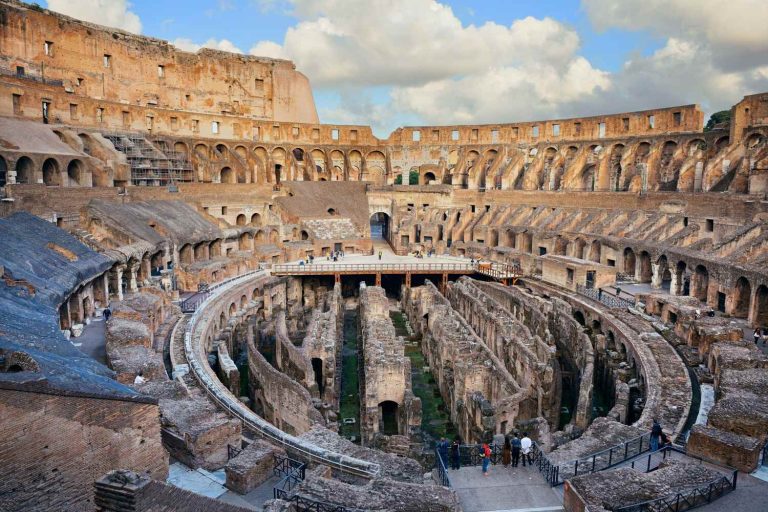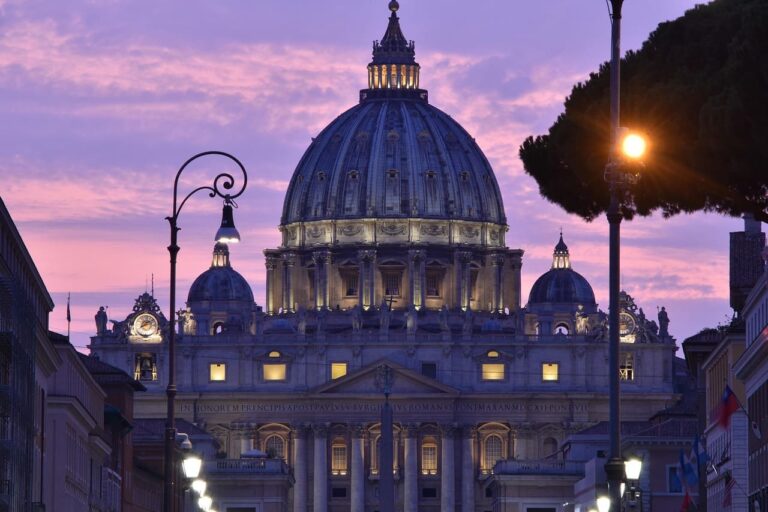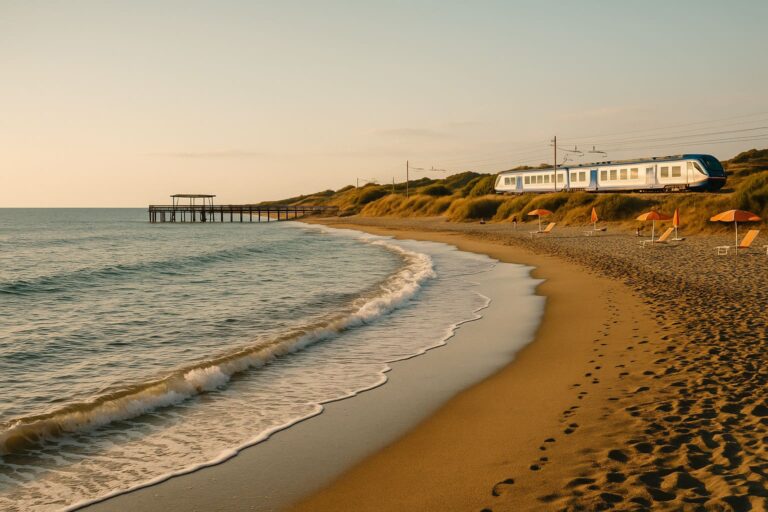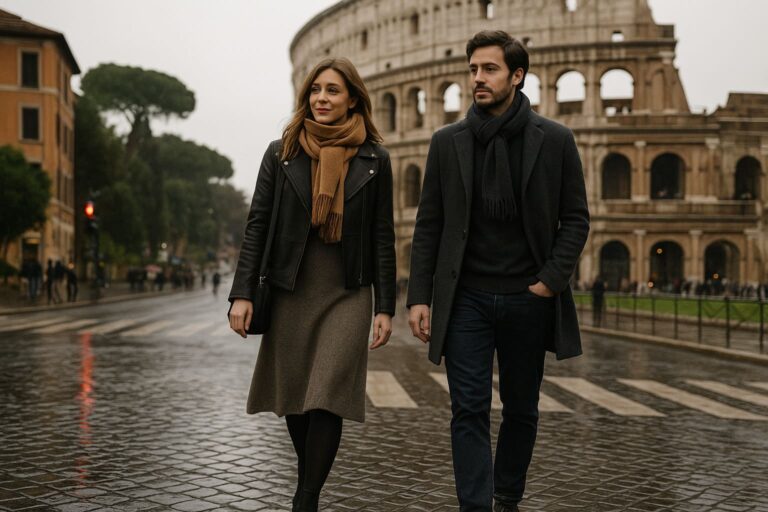How many days do you need in rome — real timelines, easy itineraries & stress-free planning
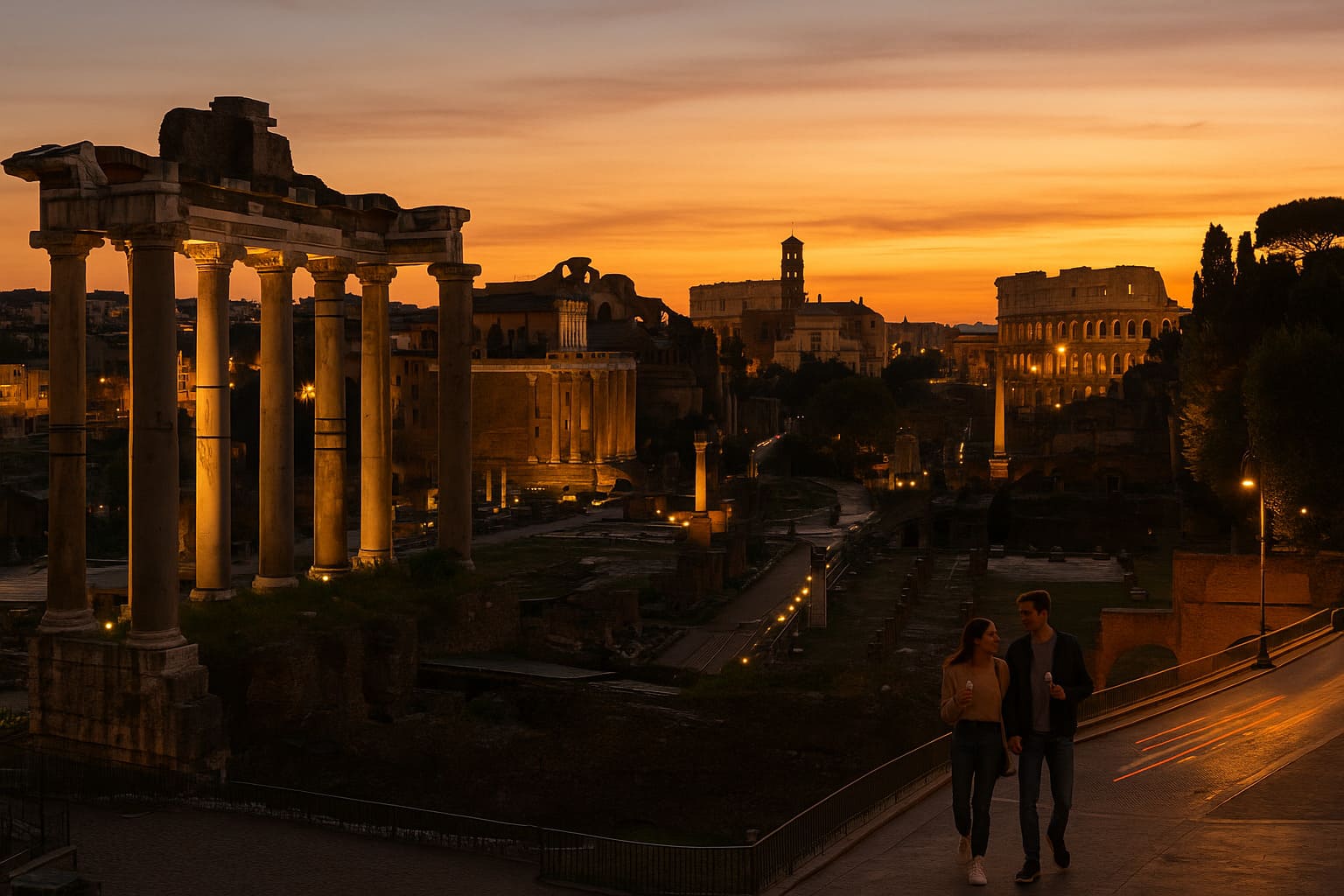
You’re asking how many days do you need in Rome because you want a plan that actually fits real life. Short version: 3 full days is the sweet spot for first-timers. You’ll see the Colosseum, Roman Forum, Vatican Museums & Sistine Chapel, St Peter’s Basilica, and the evening magic of Trevi Fountain, Piazza Navona, and the Spanish Steps without sprinting. If you can spare it, 4 days feels perfect—you add a slower morning, a food tour, or the catacombs. 2 days works as an express “greatest hits,” and 5+ days lets you fold in day trips or just live the city.
How to choose your number (and pace)
Think in blocks of half-days. Most headline sites are a half-day each once you add security, walking, and breaks. For example, the Vatican Museums + Sistine Chapel comfortably fills a morning/early afternoon, and Colosseum/Forum/Palatine fills the other half. Booking official timed tickets is the difference between smooth and chaotic days (links below when we cover each area). Your Rome itinerary will feel calmer if you keep one major site per half-day and treat the rest as bonus wandering.
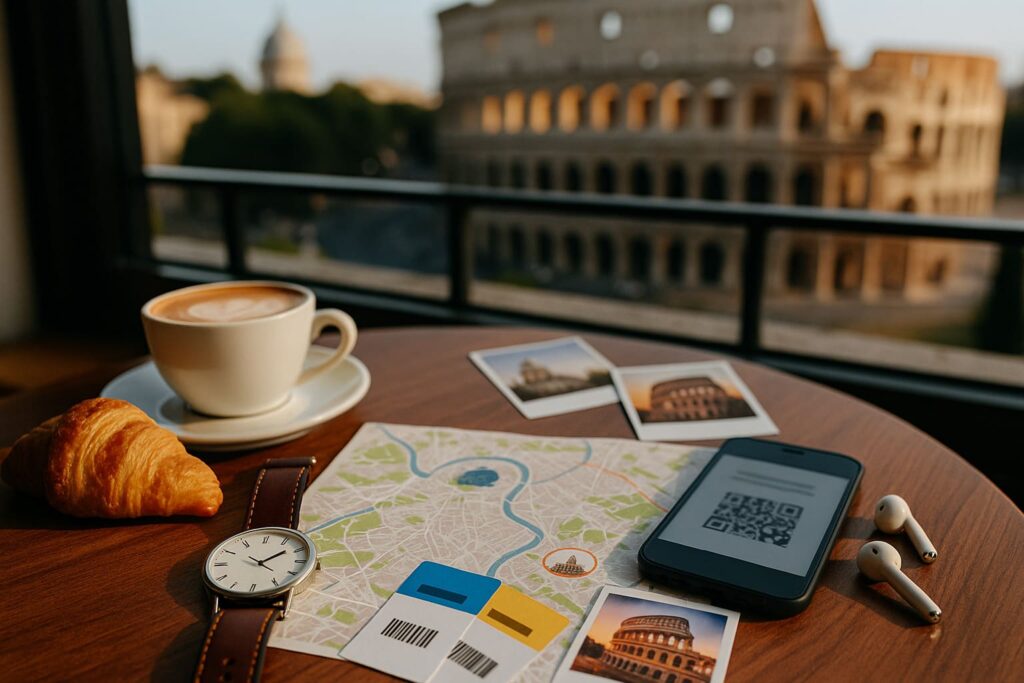
A simple 2-day express plan (yes, it’s doable)
Day 1 — Ancient core + Centro Storico
Morning: Colosseum, Roman Forum, Palatine Hill (one ticket covers all three). Afternoon: espresso and a slow walk across Via dei Fori Imperiali into the Centro Storico. Evening: Trevi Fountain → Spanish Steps → Piazza Navona loop, dinner nearby.
Day 2 — Vatican & Trastevere
Morning: Vatican Museums & Sistine Chapel, then St Peter’s Basilica (free entry; security line). Afternoon: cross the river; gelato along the way. Evening: trattoria in Trastevere or Prati.
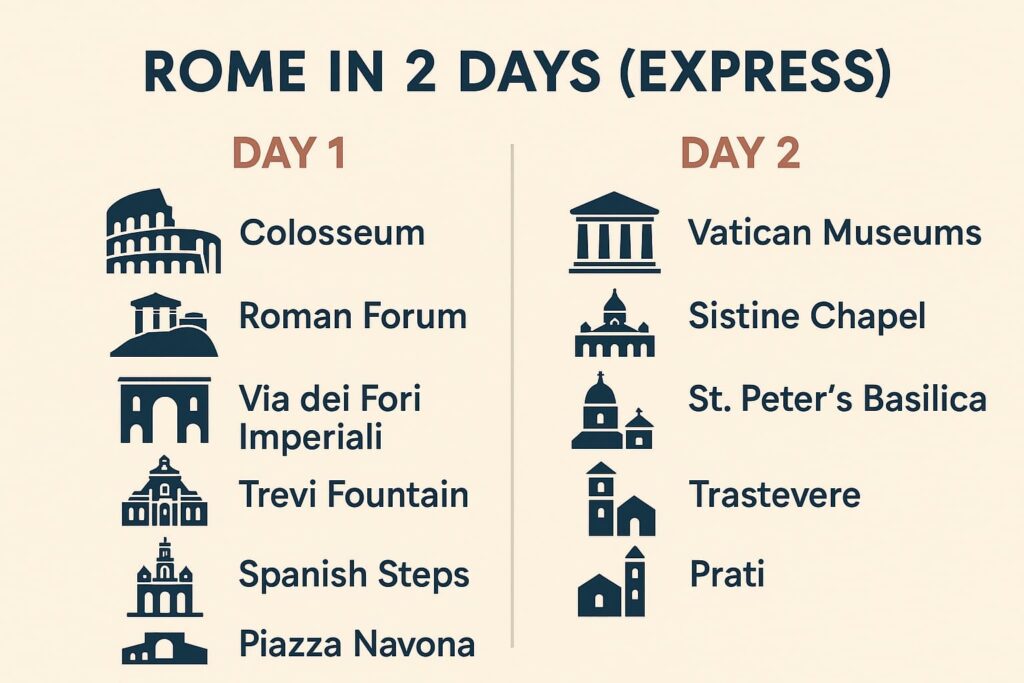
Booking tip: buy Colosseum/Forum/Palatine tickets on the Parco archeologico del Colosseo official pages; they list opening times, ticket types, and what each option includes. This keeps your timing precise and avoids reseller markups.
The ideal 3-day Rome itinerary (balanced & unhurried)
Day 1: Colosseum/Forum/Palatine (morning), siesta or lunch in Monti, then the evening Centro Storico loop (Pantheon, Trevi, Spanish Steps, Navona).
Day 2: Vatican Museums & Sistine Chapel (morning), St Peter’s Basilica (climb the dome if you like heights), stroll the river to Castel Sant’Angelo, dinner in Prati.
Day 3: Choose a theme:
- Art & gardens: Borghese Gallery (timed entry) and Villa Borghese park.
- Underground Rome: catacombs tour on the Appian Way + Aventine and Testaccio for dinner.
- Food focus: morning food tour, then markets (Testaccio, Trionfale) and a pasta class.
This format keeps your vacation to Rome relaxed while covering classic things to see in Rome.
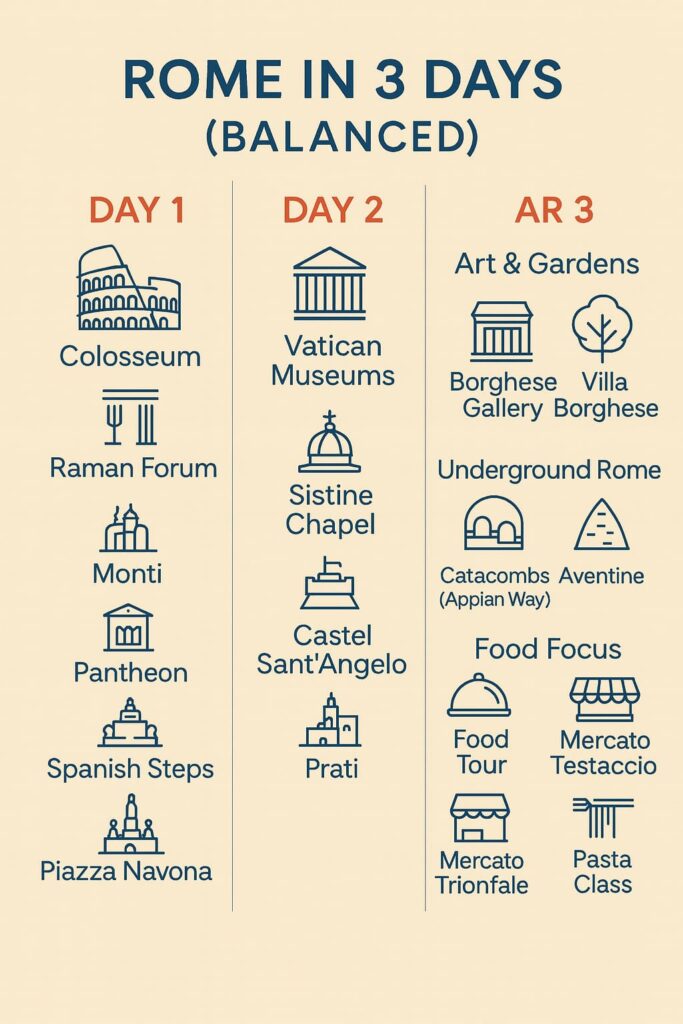
Four days in Rome (the “perfect” version)
With 4 days, you get room to breathe. Add one of these without crowding your schedule:
- Ostia Antica half-day: Roman ruins in a quiet park setting, less intense than Pompeii.
- Tivoli: Hadrian’s Villa + Villa d’Este fountains.
- Jewish Ghetto + Teatro Marcello loop with artichokes in season and a slow Tiber walk.
- Food tour or pizza-making class to balance the museums.
You’ll still have happy energy at dinner—essential if you want to try some of the best restaurants without crashing early.
Five days (or more): live here for a minute
Settle in a neighborhood: Trastevere, Testaccio, Monti, or Prati. Visit smaller churches and courtyards, take a bus tour for an overhead view, or spend a morning in EUR for 20th-century architecture and the surprising Museum of Roman Civilization (when open). Plan a lazy lunch, then watch the city shift into evening light from Pincio Terrace or Giardino degli Aranci.
Timing truths most guides skip
- Queues are part of the day. Even with timed entries, expect bag checks and corridors. That’s why we count big sites as half-days.
- Mondays & Sundays change the rhythm. Some museums close Mondays; Sunday can be crowded near St Peter (Angelus at noon) and calmer elsewhere.
- Heat & holidays: In summer, start early, pause at midday, resume at sunset. In winter, shorter daylight means fewer long walks—use evenings for indoor tours in Rome Italy (wine bars, cooking classes).
- Shoes > outfits. Rome is stone, stairs, and cobbles. Comfortable footwear buys you an extra church or piazza each day.
When you should add or remove a day
Add a day if you want all of these: touring inside the Colosseum (arena/underground), the full Vatican Museums, a food tour, and a long evening wander.
Remove a day only if you’re happy to see some icons from the outside (e.g., Trevi/Spanish Steps) and go deep on just two interiors (usually Vatican + Colosseum/Forum).
Official booking links you’ll actually use
When you plan how many days in Rome is enough, lock the two “load-bearing” bookings first:
- Vatican Museums & Sistine Chapel: reserve on the Vatican Museums official site. It lists tickets, hours, and services so you can pick a morning that fits your pace.
- Colosseum/Forum/Palatine: check Opening times & tickets on the Parco archeologico del Colosseo site to compare the standard 24h ticket with arena/underground “Full Experience” options.
Sample half-day timing (so you can see the math)
Morning Vatican block (3–4 hours): security, galleries, Sistine Chapel, walk to St Peter’s (optional dome climb adds ~60–90 minutes).
Afternoon ancient block (3–4 hours): timed entry for the Colosseum, then stroll the Forum paths and up to the Palatine viewpoints.
Add evening piazzas and dinner, and you’ve filled a satisfying day without rushing.
Story time: two travelers, two clocks
Mila has 2 days. She books a morning Vatican slot and an afternoon Colosseum slot on day one; day two she walks the Centro Storico loop, tosses a coin into Trevi Fountain, and ends in Trastevere. She goes home happy—she saw what she came for.
Jonas has 4 days. He spreads the big sites across days 1–2, sleeps in on day 3 and takes a catacombs tour, then spends sunset at Piazza Navona before dinner. On day 4 he takes a cooking class and wanders Testaccio market. He leaves with energy, not FOMO.
Smart sequencing (your Rome itinerary won’t collapse)
Day 1: Ancient Rome in the morning, Centro Storico in the evening
Day 2: Vatican morning, Trastevere or Prati at night
Day 3: Your theme block (museums / catacombs / food tour)
Day 4+: Day trip or neighborhood deep dive
This order limits long cross-town moves and keeps your legs fresh for sunset walks.
Micro-tips that save hours
- Book timed entries first, then arrange meals and strolls around them.
- Arrive 15–20 minutes early for major entries.
- Use early mornings for photos at Trevi and the Spanish Steps.
- Eat near where you finish, not where you start—Rome rewards the unplanned trattoria on your route back.
- Leave one night unplanned for a surprise: an impromptu food tour, a tiny wine bar, or a gelato crawl.
FAQ – How many days do you need in rome
How many days in Rome is enough for a first trip?
3–4 days. You’ll visit the core sites and still have time to wander and eat well.
How many days do you need in Rome if you’ve been before?
2–3 days to revisit favorites and add a theme (art, food, or catacombs).
Do I need a guide?
Not always, but a half-day guide for Vatican or Forum/Palatine can turn stones into stories—great value if you love context.
Can I do Rome as a weekend?
Yes—book Vatican and Colosseum before you fly, and keep evenings open for the Centro Storico.
What about Mondays and holidays?
Some museums close Mondays; check hours when planning a trip to Rome and shift your blocks accordingly.
Wrap-up
How many days do you need in Rome? Aim for 3 full days; 4 is perfect if you want slower meals, a food tour, or the catacombs. Use half-day blocks for the Vatican and Colosseum/Forum/Palatine, and spend evenings in the Centro Storico. Book official timed tickets (Vatican Museums and Parco archeologico del Colosseo) and you’ll turn a good schedule into a great one.

